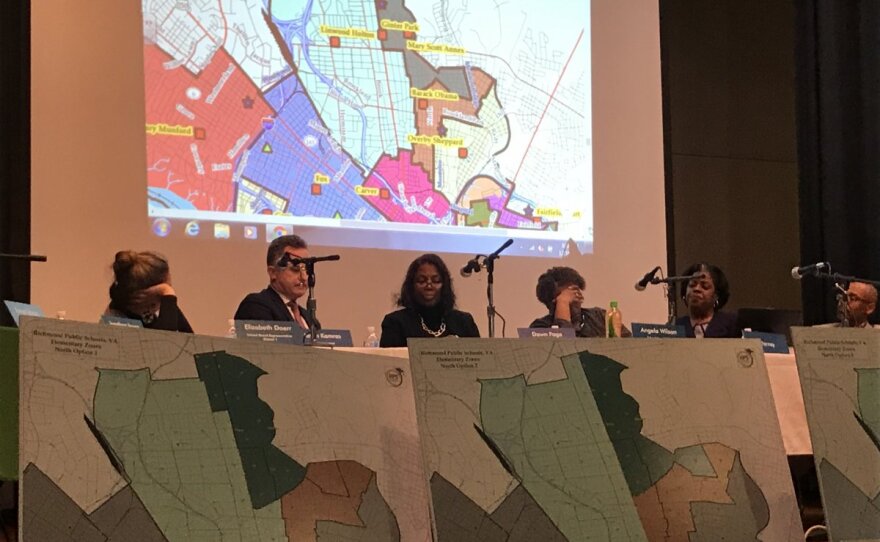Richmond’s school board voted Monday night 6-3 not to merge Barack Obama, Ginter Park and Linwood Holton Elementary schools through what’s called school pairing and instead leave the district’s current school zones on the Northside in place.
“Richmond has a lot of healing to do,” said Richmond Public Schools board chair Dawn Page in an interview following the vote.
Board members Kenya Gibson, Patrick Sapini and Felicia Cosby voted in support of a different proposal that would have sent about 160 Holton students to Ginter Park, and 90 Ginter Park students to Obama. But that vote was shot down by other board members including Page, leaving no zone changes to the city’s Northside.
“The new options that we received less than two weeks ago, they weren’t properly vetted,” Page said. “You can’t make decisions within a week or two when there has been a lengthy process prior.”
The decision came following a two-hour public comment period about rezoning options. The school board has been working to redraw school zones throughout the city, in part, to increase student diversity.
The majority of the discussion centered around option X, the only option that would have mixed up the student populations at the three schools by drawing one big zone around all three and sending kids grades K-2 to Ginter Park and Barack Obama, and grades 3-5 to Holton Elementary. It was drafted by rezoning contractor Cropper GIS at the request of the city’s rezoning committee.
Supporters of school pairing held yellow signs that said “Better Together” while others held pink “We are Ginter Park” and blue “We are Obama” signs expressing opposition to the proposed merger.
Richmond Education Association president Milondra Coleman said she preferred maintaining the status quo.
“I am not inherently opposed to diverse schools,” Coleman said. “I have not heard any Northside proposals, however, that I can comfortably support.”
Richmond parent Mary Caton Lingold spoke in support of a three-way merger between Holton, Ginter Park and Obama Elementary schools designed to increase student diversity. She said her kindergartener is zoned for Holton, even though they live much closer to Ginter Park Elementary and Barack Obama Elementary.
“It’s time for white families in the city to bear the burden of change,” Lingold said. “Let this be a reckoning for white families in Northside and across Richmond. We must realize our role in perpetuating segregation and the underfunding of schools.”
46% of students at Holton Elementary are white, compared to just one percent of students at Ginter Park Elementary and 6% of students at Barack Obama Elementary. Further, only about 26% of students at Holton are economically disadvantaged, compared to 77% of students at Ginter Park and 66% of students at Barack Obama.
Holton is one of only a few elementary schools in the district with a large percentage of white students. 61% of students at Fox Elementary are white, and 75% of students at Mary Munford Elementary are white. The school board voted against proposals to merge Fox and Mary Munford with the majority-black Cary and Carver Elementary, respectively, on December 2.
Kenya Gibson, school board member representing the city’s third district, says she’s not convinced that school pairing is a good fit for Richmond.
“I think that there are merits to it [school pairing],” Gibson said in an interview earlier this month. “But I think it's something that needs to be thought through. So voting to adopt it now would be premature. I think we just still have some work to do.”
Gibson called it a divisive “lightning rod topic” among middle class white families, and said she’d need to hear from more African American and Hispanic families whose voices she felt were largely missing from the discussion before reconsidering the option.
“It's just not authentic to be doing something in the name of racial equity and to be doing it without including the communities that it's going to impact the most,” Gibson said.
Parents like Melissa Yeager, part of the group StayRVA, insist that pairing would have been the most meaningful way to create lasting integration and equity in Richmond Public Schools.
“The disparity amongst our schools is really shocking on all kinds of levels,” Yeager said. “Of all of the various proposals that have been put forward, none of them has as profound an impact as pairing on mixing up the population, on mixing up the different levels of socioeconomic status and addressing the imbalance in resources.”
She recently started a petition to drum up support for pairing on Richmond’s North Side. As of Monday evening, it had over 200 supporters. But, Yeager said implementing something like school pairing to take effect next fall would be too fast. She would have liked to see the school board vote to take a year to get more community feedback from Ginter Park and Barack Obama families before deciding to move forward with the plan.
“People have really meaningful obstacles to transportation that could be a significant difficulty, and having kids at more than one elementary school,” Yeager said. “If we can't find a way to overcome those, then we shouldn't put the most vulnerable people in our system at an even greater stretch.”
The school board approved rezoning changes earlier this month in Richmond’s East End, West End and Southside. These changes are expected to take effect next summer.



